The Cornell Lab Bird Academy › Discussion Groups › Inspiring Investigations through Citizen Science › Encouraging Observations
-
I wanted to say that I love the lemon activity. I have used that activity at the start of all my ECO programs since the first time I took this class many years ago. It is such an amazing activity that gets students to use all if their senses plus it also gets them exploring with science tools.II have scales, tape measures, magnifying glasses, etc available for them to use. The most impactful thing about the sound map was hearing all of the natural sounds, even in an urban area filled with houses. Observation skills are such an important part of the programs I run and we spend a lot of time learning this skill. I notice, I wonder and it reminds me.... are phrases I introduce my students to, not only in my environmental programs, but also my art club, zoo club, etc. One sense that students take for granted is sight. They often just look at something and think they are seeing everything. One thing I have introduced, besides magnifying glasses and/or a digital microscope so they can see smaller details, is a dental mirror. The mirror gets them to look at things a bit differently from different angles and maybe look at parts that are harder to see or obscured. The kids absolutely love this simple, inexpensive tool. I also get students touching things. Loose parts are a large part of our early childhood program. The loose parts allow them to touch and manipulate various natural objects. I have done the sound map before with students and I've also done an activity where they record the sounds using describing words. And I've done it where they draw the sound waves: pitch, frequency, etc. (This is a good one for older students)

-
I most enjoyed hearing a sound and then figuring out where it was on my map. It was like a spacial exercise or puzzle for my brain. I could hear a bird chirping and try to decide how far away it was. Whenever I'm outside, I usually listen for small sounds around me that help me find creatures, like insects, herps, or birds. But when I did this exercise, I noticed constant sounds farther away that I would normally block out. I also had to make sure that I didn't focus on what I was writing so much that I could miss sounds. This would be a great activity to do with kids and adults to help connect them with the nature around them and to help with multitasking!

-
 This time I decided to measure the noise using my Decibel X app on my phone (I use this for other fieldwork around Hong Kong), just to see what the averages and maximums were - it says it is still a quiet street. I beg to differ with all the construction nearby and the general urban buzz that permeates my space!
Once you get in the mode to do this activity, it sometimes is hard to stop after the set amount of time because one's curiosity has been triggered and you want to know: (1) what else is out there?; (2) how frequently do I hear the things I've heard before?; (3) what do I recognize vs. what I don't recognize?; and of course, (4) what is that? and (5) why is the noise happening?
When I've done this activity with students before, it has usually been in the country park areas, rather than amongst buildings, but this being Hong Kong, you can often still hear a variety of city noises that bounce up the hillsides, so students still mentioned construction or urban transport noises alongside bird chirps. I encourage them to consider distance and direction, and to try to represent them on their sketches as accurately as they can. Certain noises repeat and often in the same area, so I ask them to keep a tally of frequency. You can end up with quite a lot of data this way, and can be analyzed using some descriptive statistics too (depends on how analytical you want to get)! Usually it is with eyes closed for the first chunk of time, and then with the eyes open. Students recognize that it's helpful to start with just "listening" because it reduces the information overload, unlike with "seeing" - where there is lots to distract you. The listening first exercise helps to focus the second "seeing & listening" part of the exercise and they 'look' for the noise, rather than just look anywhere and everywhere. When I've done it with younger students (primary and middle school), it hinges on curiosity and questioning; with older students (high school), we layered it with mindfulness and well-being as well.
If students are generally in the same area, it is interesting to also consider the similarities and differences in what the students picked up on - a great opportunity to consider consciousness/awareness and how it is linked to what we know. e.g. some don't 'hear' birds having different songs because they may not recognize these differences based on lack of experience or knowledge about different bird species. Or, sometimes the habitualization of noise means that some noises are really heard anymore. There is fascinating research on urban birds that have shown that they've adjusted the pitch of their songs to be higher than the background urban noise just to be heard (U. of HK ecology department research).
This time I decided to measure the noise using my Decibel X app on my phone (I use this for other fieldwork around Hong Kong), just to see what the averages and maximums were - it says it is still a quiet street. I beg to differ with all the construction nearby and the general urban buzz that permeates my space!
Once you get in the mode to do this activity, it sometimes is hard to stop after the set amount of time because one's curiosity has been triggered and you want to know: (1) what else is out there?; (2) how frequently do I hear the things I've heard before?; (3) what do I recognize vs. what I don't recognize?; and of course, (4) what is that? and (5) why is the noise happening?
When I've done this activity with students before, it has usually been in the country park areas, rather than amongst buildings, but this being Hong Kong, you can often still hear a variety of city noises that bounce up the hillsides, so students still mentioned construction or urban transport noises alongside bird chirps. I encourage them to consider distance and direction, and to try to represent them on their sketches as accurately as they can. Certain noises repeat and often in the same area, so I ask them to keep a tally of frequency. You can end up with quite a lot of data this way, and can be analyzed using some descriptive statistics too (depends on how analytical you want to get)! Usually it is with eyes closed for the first chunk of time, and then with the eyes open. Students recognize that it's helpful to start with just "listening" because it reduces the information overload, unlike with "seeing" - where there is lots to distract you. The listening first exercise helps to focus the second "seeing & listening" part of the exercise and they 'look' for the noise, rather than just look anywhere and everywhere. When I've done it with younger students (primary and middle school), it hinges on curiosity and questioning; with older students (high school), we layered it with mindfulness and well-being as well.
If students are generally in the same area, it is interesting to also consider the similarities and differences in what the students picked up on - a great opportunity to consider consciousness/awareness and how it is linked to what we know. e.g. some don't 'hear' birds having different songs because they may not recognize these differences based on lack of experience or knowledge about different bird species. Or, sometimes the habitualization of noise means that some noises are really heard anymore. There is fascinating research on urban birds that have shown that they've adjusted the pitch of their songs to be higher than the background urban noise just to be heard (U. of HK ecology department research). -
You raise some interesting points that I hadn't considered. First the Decibel X app to measure the depth of the sounds. I also like how you use this in different ways to work with different ages and include the mindfulness/consciousness/awareness component. I thought your point about not 'hearing' the different birds was very interesting and this reminds me of how challenging it can be to share the excitement of bird songs with beginners, but how challenging it can be for them to differentiate. I also was interested to consider the habitualization of sounds. I walk the same road many days of the week and listen for bird sounds. I try to keep a mental note of them each morning, but as I proceed through the spring and summer, I think I don't always note the ones I hear, like robins in early spring are so very special, and then I don't always recognize them later on. Finally, your reference to urban birds and how they have adjusted the pitch of their songs is very interesting. I wonder if this happens where they are breeding, or if adjustment happens in their non breeding place as well.
-
-
The most impactful thing about creating my sound map was listening for 10 minutes without doing anything else. I think students would find this a bit difficult, as well. We multi-task constantly. The challenge for me this school year will be to make modifications for the sound map for my hearing impaired student. I will consult the teacher of hearing impaired to make modifications for this student. Some of the things I heard included leaves rustling in the wind, crickets chirping, a neighbor's air conditioner, traffic on a highway (Rt 50) down the hill, a motorcycle revving his engine, the metal part of the flags and flag poles clanging, and 3 different kinds of birds chirping. This is a great activity. I have taught a similar activity when I focus on onomatopoeia during my poetry unit.

-
The space to fully observe, without technology dinging or ringing. I've done this activity a few times, both in trainings I've attended and those I've led. For me I find it helpful to pick a place that's far enough away from very obvious distractions (and temptations) to open your eyes. So, a spot far from a road or gathering - at least for the first time doing a sound map. One of my most memorable maps came from a very relaxing wellness retreat - though you would never know that looking at my map that day. I chose to represent sound intensity with lots of wavy and obnoxious lines, that consumed anything else on the paper - as this was how it felt while I was experiencing all the motor sounds from boats, cars, and planes. I think it's important to guide students through observation, so providing prompts like : - listen for the closest sound - what sound do you hear the loudest, the farthest away -what sound makes you feel happy? This helps children, even adults, focus their attention on the experience and the senses by giving them suggestions of HOW to pay attention. Love this activity combined with a sit spot so the observer can compare changes over time, season, weather, etc and start to explore questions, patterns, trends...
-
I like the prompts for observing. This is a great idea. I guess I never thought of distance of sounds and how sounds make us feel. I plan on incorporating both of these ideas when I do sound maps in the future. Thanks!
-
OOOH, I like the prompts too! I will use these!
-
-
Sitting and focusing on the sounds around you is most impactful. Repeating this exercise at different times of the year, or year by year could lead to interesting discussions. Questions about what different sounds are heard at different times of the year; if there are more sounds or less sounds from year to year. Does the weather affect the sounds you are hearing; have any changes occurred that may affect the sounds (a pandemic causing less people to be driving, a new road causing more traffic, a new shopping center or housing nearby. I heard mostly birds chirping which makes me wonder what species I may have around me. Stopping everything else, and listening can help us relax, and start noticing our outdoor surroundings, which in turn will cause us to start asking questions. I've been working outside today, (one of very few nice weather days this summer) and have observed a hummingbird visit various flowers, and a tomato plant on my deck, but it isn't going to the hummingbird feeder. Does it see the feeder, is there enough food in the feeder, what kind of hummingbird am I observing? When I take the time to listen, I always have questions. qhRT

-
The sound map is somewhat of a Zen experience. Taking time to stop and just listen is rare. The experience was restful and almost restorative because you just listen. This quieting time helps anyone stop and collect your thoughts. For adults this time is just the opposite of multi-tasking. The world is filled with distractions and the quieting experience from the sound mapping activity helps improve one's focus. I think that doing this often and practicing this activity may help establish a habitat of thinking first. It also creates a space when you can evaluate your thoughts and organize them. In reading some of the comments, words like being mindful, critical thinking and present in the moment were used. For teachers this activity provides a great balance during a class by spending quiet times interspersed with discussion. The quiet times develops keener observational and thinking skills. Here is my map done during lunch break on a weekday in the subdivision. There are several mature oak trees where I live. I am sure that doing this activity in a nature area or a park would be better. This is a great way to spend instructional time with students.

-
I enjoyed doing the sound map. I did it with my six and eleven year old daughters. It caused us to be more mindful of our surroundings. I would like to try this in different settings around town. We'll give it a try when we go to the local park later this morning.

-
Try doing it with your eyes closed next time! It's a lot of fun and allows even more attention to sound.
-
-
 I think for me it was a lot of heard was expected. For many of my student not having a "name" for the sound might be an issue and they may not write it down. I think we would need to talk about the fact that they may not have a name for the sound but it is still an observation and how important that is. I might be able to identify the bird call but a student might be able to tell that he bird sounds are different.
When it comes to doing the observations in general and using all their senses I think it will be important to note that taste will be the hardest to note.
I think having a conversation with kids about what it means to fully participate and observe will be one of the first things I have to start. Brainstorm ideas of what that looks like and maybe even feels like. Sometimes middle schoolers have a hard time just sitting and listening.
I think for me it was a lot of heard was expected. For many of my student not having a "name" for the sound might be an issue and they may not write it down. I think we would need to talk about the fact that they may not have a name for the sound but it is still an observation and how important that is. I might be able to identify the bird call but a student might be able to tell that he bird sounds are different.
When it comes to doing the observations in general and using all their senses I think it will be important to note that taste will be the hardest to note.
I think having a conversation with kids about what it means to fully participate and observe will be one of the first things I have to start. Brainstorm ideas of what that looks like and maybe even feels like. Sometimes middle schoolers have a hard time just sitting and listening. -
I agree - the not having a 'name' for the sound is an interesting discussion that I've had and it becomes a guessing game with gestures, noises and associations of other sounds that are similar. I think some students were challenged by that and started to focus on other sounds they did more readily recognize, while others really dug in to try to identify it, sometimes collaboratively, which cut into the noise! I would often have to remind them about the student silence side of the whole activity. With older students I've had them spread out further apart from each other, but with younger students along trails, for safety we did keep them a little closer (than the activity would actually warrant).
-
-
 Sound maps are a great tool to use with kids and adults alike. Not only does it help with observation skills but we all need to take a moment to take the time to focus on what we have and what is around us, instead on focusing on where we are going or what we need to do next. Emotional Health and mindfulness are an ever-growing topics. If we can get youth to slow down, gain a better sense of the world around them and pay attention to small details; and maybe ask them how they feel at that moment we will be teaching youth life skills they need to be successful. Does taking a break to be present help you feel calmer, relaxed? Sound maps are also a great way to get youth to observe and just be present in their surroundings. A jump for a more in-depth conversation later with youth making predictions, asking questions and following with open inquiry learning opportunities.
I also like the idea of “sit-spots.” A sit spot is an outdoor place that you spend at least 5 minutes while observing everything around you. When you choose a sit spot you want it to be easy to visit, free of distractions, comfortable and close to things that you want to observe.
Encourage youth to use their senses to observe and write in a journal about their observations to make inferences on changes they see overtime.
Look for movement. What animals do you see, what are they doing?
What did you hear in your sit spot? Do animals notice you? Do they get more comfortable with your presence?
What can you touch around you? Are certain plants softer when they are young? Do the mosses, rocks, trees and plants feel different when they are wet or dry? Does the sun feel good on your neck today?
Can you smell anything? If so, can you find it? Can you identify it?
Using a sit spot gently encourages us to be mindful of our surrounds and to appreciate ALL of the things that are happening around us. They help us to pause in our daily routine and to make sense of our natural surroundings while relying only on our own senses. Sit spots encourage critical thinking, independence and self-reliance while also getting us outside!
Week 2
Sound maps are a great tool to use with kids and adults alike. Not only does it help with observation skills but we all need to take a moment to take the time to focus on what we have and what is around us, instead on focusing on where we are going or what we need to do next. Emotional Health and mindfulness are an ever-growing topics. If we can get youth to slow down, gain a better sense of the world around them and pay attention to small details; and maybe ask them how they feel at that moment we will be teaching youth life skills they need to be successful. Does taking a break to be present help you feel calmer, relaxed? Sound maps are also a great way to get youth to observe and just be present in their surroundings. A jump for a more in-depth conversation later with youth making predictions, asking questions and following with open inquiry learning opportunities.
I also like the idea of “sit-spots.” A sit spot is an outdoor place that you spend at least 5 minutes while observing everything around you. When you choose a sit spot you want it to be easy to visit, free of distractions, comfortable and close to things that you want to observe.
Encourage youth to use their senses to observe and write in a journal about their observations to make inferences on changes they see overtime.
Look for movement. What animals do you see, what are they doing?
What did you hear in your sit spot? Do animals notice you? Do they get more comfortable with your presence?
What can you touch around you? Are certain plants softer when they are young? Do the mosses, rocks, trees and plants feel different when they are wet or dry? Does the sun feel good on your neck today?
Can you smell anything? If so, can you find it? Can you identify it?
Using a sit spot gently encourages us to be mindful of our surrounds and to appreciate ALL of the things that are happening around us. They help us to pause in our daily routine and to make sense of our natural surroundings while relying only on our own senses. Sit spots encourage critical thinking, independence and self-reliance while also getting us outside!
Sound maps are a great tool to use with kids and adults alike. Not only does it help with observation skills but we all need to take a moment to take the time to focus on what we have and what is around us, instead on focusing on where we are going or what we need to do next. Emotional Health and mindfulness are an ever-growing topics. If we can get youth to slow down, gain a better sense of the world around them and pay attention to small details; and maybe ask them how they feel at that moment we will be teaching youth life skills they need to be successful. Does taking a break to be present help you feel calmer, relaxed? Sound maps are also a great way to get youth to observe and just be present in their surroundings. A jump for a more in-depth conversation later with youth making predictions, asking questions and following with open inquiry learning opportunities.
I also like the idea of “sit-spots.” A sit spot is an outdoor place that you spend at least 5 minutes while observing everything around you. When you choose a sit spot you want it to be easy to visit, free of distractions, comfortable and close to things that you want to observe.
Encourage youth to use their senses to observe and write in a journal about their observations to make inferences on changes they see overtime.
Look for movement. What animals do you see, what are they doing?
What did you hear in your sit spot? Do animals notice you? Do they get more comfortable with your presence?
What can you touch around you? Are certain plants softer when they are young? Do the mosses, rocks, trees and plants feel different when they are wet or dry? Does the sun feel good on your neck today?
Can you smell anything? If so, can you find it? Can you identify it?
Using a sit spot gently encourages us to be mindful of our surrounds and to appreciate ALL of the things that are happening around us. They help us to pause in our daily routine and to make sense of our natural surroundings while relying only on our own senses. Sit spots encourage critical thinking, independence and self-reliance while also getting us outside!
Week 2
Sound maps are a great tool to use with kids and adults alike. Not only does it help with observation skills but we all need to take a moment to take the time to focus on what we have and what is around us, instead on focusing on where we are going or what we need to do next. Emotional Health and mindfulness are an ever-growing topics. If we can get youth to slow down, gain a better sense of the world around them and pay attention to small details; and maybe ask them how they feel at that moment we will be teaching youth life skills they need to be successful. Does taking a break to be present help you feel calmer, relaxed? Sound maps are also a great way to get youth to observe and just be present in their surroundings. A jump for a more in-depth conversation later with youth making predictions, asking questions and following with open inquiry learning opportunities.
I also like the idea of “sit-spots.” A sit spot is an outdoor place that you spend at least 5 minutes while observing everything around you. When you choose a sit spot you want it to be easy to visit, free of distractions, comfortable and close to things that you want to observe.
Encourage youth to use their senses to observe and write in a journal about their observations to make inferences on changes they see overtime.
Look for movement. What animals do you see, what are they doing?
What did you hear in your sit spot? Do animals notice you? Do they get more comfortable with your presence?
What can you touch around you? Are certain plants softer when they are young? Do the mosses, rocks, trees and plants feel different when they are wet or dry? Does the sun feel good on your neck today?
Can you smell anything? If so, can you find it? Can you identify it?
Using a sit spot gently encourages us to be mindful of our surrounds and to appreciate ALL of the things that are happening around us. They help us to pause in our daily routine and to make sense of our natural surroundings while relying only on our own senses. Sit spots encourage critical thinking, independence and self-reliance while also getting us outside! -
You have shared lots of good applications - I am grateful. Thank you.
-
-
- Creating the sound map, I realized there were many more sounds around me than I expected. Working at home, I often notice sounds from nature, but didn't think there are so many I can hear in 10min.
- Another thing I noticed is the process: First when I closed my eyes, there were many sounds at the same time, and I had to slowly go through to guess what they are, trying to remember them in case they don't come back again. Then there was repetition of certain sounds, like the cicadas, and wind, and cars. And lastly, keeping background sounds in check, I looked out for new sounds. It's quite a fun activity!
- Another thing I find interesting is there was a rattling sound that I can't recognize, I think it's from some insect, and I'm very curious to know what it can be.
- I think the focusing of only 1 sense at a time could help children to observe better. Also, the time should be long enough for them to recognize things and patterns, but I wonder if there should be a maximum... For me, the longer I sit, the more I get into it, but children might get bored. Or not. It'll be interesting to find out!
- Here's my Sound Map:

-
 This activity forces you to stop, think and concentrate on what is already around you. Not on what you are cramming into your brain via smart phones etc. I think the time of ten minutes was needed because it took a while to settle down and really focus on everything. I sat for a while with my eyes closed and that helped me focus even more. I think having students complete this activity is a good way to introduce them to the world around them and make then start to see / hear. it would be interesting to complete the map only focussing on other senses such as touch and smell. I can see a lot of extension activities for this concept.
This activity forces you to stop, think and concentrate on what is already around you. Not on what you are cramming into your brain via smart phones etc. I think the time of ten minutes was needed because it took a while to settle down and really focus on everything. I sat for a while with my eyes closed and that helped me focus even more. I think having students complete this activity is a good way to introduce them to the world around them and make then start to see / hear. it would be interesting to complete the map only focussing on other senses such as touch and smell. I can see a lot of extension activities for this concept. -
What impacted me mostly as I created my Sound Map were ideas related to "time" and "repetition". I realized how long 10 minutes might seem for young children and thought about alternatives like building up to 10 minutes or adding additional time to observe depending on the students. I also considered the idea of sounds that were repeating and questions came to my mind like "How do I record repetitive sounds?", "Do I hear sound patterns ? (3 chirps of a bird 4 times)", and "What am I missing with my eyes closed?" I might have students do observations with just their ears for a while, and then with just their eyes, and eventually with both ears and eyes in order for students to be able to compare the quality, amount, and detail of the observations they are able to make of the natural world.

-
I like the just doing sounds and then just sight and then combining them. Interesting.
-
-
The most impactful aspect of creating my sound map was stopping and closing my eyes in my small backyard. I did not expect to hear all of the sounds I heard. It made me wonder, I am guilty of not stopping and "smelling the roses"? Do I hear the sounds all around me? Am I busy running around and not taking time to appreciate all of the nature and sounds surrounding my world. I think this would be a great activity for my students. We have a beautiful courtyard and a pond with a fountain filled with Koi fish and frogs. Trees, shrubs, and perennials attract lots of birds and ducks have been known to nest here, as well. Allowing my students to take time to use their senses will nurture the scientists within!

-
Abundant sounds impact me the most. Cicada insects "NZ" pulsate like a large temple choir. A whisper, "crunch, crunch" in the dry grass of a doe quietly passing by. The wind tickles my ears from the southwest. An AC unit hums on the roof. A metal roof percussion "Tap, Tap" as a cloud trades heat with the sun. Two miles away an 18 wheeler transports what someone needs. Middle school students would love this activity. Ten minutes of quiet would be like an eternity. Most of the students would quickly move to the "I wonder" part of learning. What makes the noise? Why is there a noise? Why is the big doe so quiet? How come there are so many loud insects? If the insects are so loud, why doesn't something eat them? I would encourage the use of listing and compiling the questions. High School students would benefit from this activity as well. The multiple complications of their world would have to peel back to focus. Once back in the class the "I wonder" part would begin. Or at least the search for a bird, bug noise app. I would encourage the consideration of seasonal changes, yearly changes, even historical changes.

-

 A favorite read aloud for this lesson is the Listening Walk by Paul Showers, illustrated by Aliki. The students quickly learn to observe and listen to the sounds around them once they are introduced to this lesson. Every time they are outside, they are more in tune to the sounds of nature and are excited to share.
A favorite read aloud for this lesson is the Listening Walk by Paul Showers, illustrated by Aliki. The students quickly learn to observe and listen to the sounds around them once they are introduced to this lesson. Every time they are outside, they are more in tune to the sounds of nature and are excited to share. -
Thank you for the suggestion on the book, love connecting books to activities!
-
-
I think the most impactful thing about this experience is the mindfulness it instills in the observer. It forces us to be "in the moment". Bringing this idea of mindfulness to the attention of students before and after the lesson might be a nice way to frame the act of observation. (Image to come.)
-
Beverly, Yes, I agree that being mindful will instill the observer, for and us and our students! I have not heard of the book, Listening Walk, but I will be sure to read it! Thanks for sharing.
-
-
(see below)
-
The sound map was a helpful activity for me to thoughtfully observe what I cannot see. I knew we have planes that fly by and I live close to a large street but I did not expect to hear so many sirens or planes. It forced me to focus on things I normally would tune out. I would use this similar technique to encourage my students to observe the world more fully. It is very easy for us to focus on the visible aspects, that sometimes we forget to focus on our other senses. This is also a good way to include students with visual disabilities into the group as leaders in an activity where they might excel since they have learned not to rely on visual stimulus.

-
Creating this sound map was a great way to tune out all my other senses and focus on my sense of sound. I personally have a difficult time sitting still and feel that I need to always be doing something. This activity gave me a chance to relax and just absorb what was around me. It was very peaceful. The longer I listened the more I was able to specifically pick out sounds that would normally be blended into the background. Most of the sounds that I heard would be ones that I would typically not notice. For example, when I took the time to listen I heard four different bird chirps. It truly is amazing how many individual sounds a person can hear in such a short amount of time. I did this activity in the early evening hours and it would interesting to compare it to different times of day. I think students would love this activity. I would take my students on a nature walk along the trails by our school and stop at a certain point. With the clipboard and paper they would have the choice to sketch pictures or write words to describe what they hear. At the end of the activity I know they would enjoy sharing their sound map with their peers. A fun extension of this activity would be to keep these sound maps and go back to the same location during different seasons and compare/contrast the similarities and differences between the sounds they heard.

-
I love your idea of going back to the same location and mapping the sound to see how it has changed over the seasons.
-
-
 I
I usually listen to the sounds outside because I am always trying to identify the birds that are near by me. I have not made a Sound Map before today. I think this is a great idea to share with students. It is an easy way to engage students with their natural surroundings. For students who enjoy drawing and sketching, the Sound Map could lead to activities in art for them. Even if students don't know the name of the bird that is making the sound, the student will be able to use their imagination to draw what the bird might look like as it is singing.
I
I usually listen to the sounds outside because I am always trying to identify the birds that are near by me. I have not made a Sound Map before today. I think this is a great idea to share with students. It is an easy way to engage students with their natural surroundings. For students who enjoy drawing and sketching, the Sound Map could lead to activities in art for them. Even if students don't know the name of the bird that is making the sound, the student will be able to use their imagination to draw what the bird might look like as it is singing. -
Sound maps could be a great link into art. Students who hear the same thing could have different visual interpretations.
-
-
II live in a pretty urban area, and the majority of the sounds I heard were man-made -- a lot of cars, people talking, the sound of wind chimes. It'd be interesting to do this activity with students in a variety of places. I also really like the way this sound map activity was organized --rather than just making a list of things you hear, you are mapping sounds and putting yourself in the center. I also like that you can use symbols and images, for students who may be new to reading and writing. I really liked the lemon lesson too -- I think adding a competitive edge and real reason behind making the observations makes the importance of both strong observations and strong evidence really clear to students.

-
You brought up a good point in your comments. Perhaps the students could separate the sounds by human made vs. natural. Last summer when I was vacationing, I found a spot that was devoid of any human made sounds - it was truly quiet. Both my husband and I commented on the fact that we had not been a place like this for some time. Our lives are filled with noises daily.
-
-
The most impactful thing for me was closing my eyes while creating it. Doing so draws the attention to sound by eliminating the distraction of sight. Also, by eliminating sight I noticed scents that directed me to hear what I might be smelling, in my case the freshly cut grass, I then noticed the faint sound of the lawnmower. I could definitely use this technique with children, encouraging them to use their senses to detect things they may not otherwise notice and incorporate that into how animals
 use their senses to locate food.
use their senses to locate food. -
Elisabeth, I also thought that closing my eyes really helped me focus on my sense of hearing. You had such a great idea when you discussed how you could incorporate this alongside how animals use their senses to find food. I think children would love this activity and would also be able to make a connection between how they use their senses compared to animals. Thank you for this idea. I could use this with our science unit on animal survival. I thought it was really neat that you used your sense of smell as well to help you detect other sounds like the lawnmower.
-
Elisabeth, I agree. I typically depending on many of my senses working together. By completing my Sound Map it really helped me to stop and listen to the world around me. Thanks for sharing.
-
-
 My realization of how I became more and more able to be specific the longer I listened.
Practicing and then reflecting bring the concept home in the mind.
My realization of how I became more and more able to be specific the longer I listened.
Practicing and then reflecting bring the concept home in the mind.
-
I live in an urban centre, and what I found impactful was how many 'nature sounds' I could still hear even amongst the roar of nearby cars. Despite the sounds of the city I could still here songbirds, the wind, and the rustling of leaves, and I bet if I sat for longer I would hear more animals as well. I think that this is a really great acclimatization activity for kids, as it really gets them more engaged in their environment. I think scavenger hunts can be a really fun way to have children observe the natural world more fully, especially if you include smaller natural items that people don't always consider, because you really have to use observational skills. Another way I think you can engage children in observing the natural world more fully is by doing a "5 Senses" treasure hunt in which you get the children to find objects that correspond with a different sense (however, don't let them actually taste anything, just hypothetically tasty). For example, you can ask students to find something that is smooth and allow them to compare their items.

Read More:
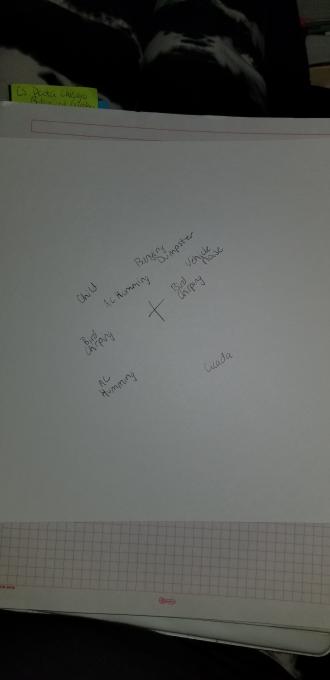

 This time I decided to measure the noise using my Decibel X app on my phone (I use this for other fieldwork around Hong Kong), just to see what the averages and maximums were - it says it is still a quiet street. I beg to differ with all the construction nearby and the general urban buzz that permeates my space!
Once you get in the mode to do this activity, it sometimes is hard to stop after the set amount of time because one's curiosity has been triggered and you want to know: (1) what else is out there?; (2) how frequently do I hear the things I've heard before?; (3) what do I recognize vs. what I don't recognize?; and of course, (4) what is that? and (5) why is the noise happening?
When I've done this activity with students before, it has usually been in the country park areas, rather than amongst buildings, but this being Hong Kong, you can often still hear a variety of city noises that bounce up the hillsides, so students still mentioned construction or urban transport noises alongside bird chirps. I encourage them to consider distance and direction, and to try to represent them on their sketches as accurately as they can. Certain noises repeat and often in the same area, so I ask them to keep a tally of frequency. You can end up with quite a lot of data this way, and can be analyzed using some descriptive statistics too (depends on how analytical you want to get)! Usually it is with eyes closed for the first chunk of time, and then with the eyes open. Students recognize that it's helpful to start with just "listening" because it reduces the information overload, unlike with "seeing" - where there is lots to distract you. The listening first exercise helps to focus the second "seeing & listening" part of the exercise and they 'look' for the noise, rather than just look anywhere and everywhere. When I've done it with younger students (primary and middle school), it hinges on curiosity and questioning; with older students (high school), we layered it with mindfulness and well-being as well.
If students are generally in the same area, it is interesting to also consider the similarities and differences in what the students picked up on - a great opportunity to consider consciousness/awareness and how it is linked to what we know. e.g. some don't 'hear' birds having different songs because they may not recognize these differences based on lack of experience or knowledge about different bird species. Or, sometimes the habitualization of noise means that some noises are really heard anymore. There is fascinating research on urban birds that have shown that they've adjusted the pitch of their songs to be higher than the background urban noise just to be heard (U. of HK ecology department research).
This time I decided to measure the noise using my Decibel X app on my phone (I use this for other fieldwork around Hong Kong), just to see what the averages and maximums were - it says it is still a quiet street. I beg to differ with all the construction nearby and the general urban buzz that permeates my space!
Once you get in the mode to do this activity, it sometimes is hard to stop after the set amount of time because one's curiosity has been triggered and you want to know: (1) what else is out there?; (2) how frequently do I hear the things I've heard before?; (3) what do I recognize vs. what I don't recognize?; and of course, (4) what is that? and (5) why is the noise happening?
When I've done this activity with students before, it has usually been in the country park areas, rather than amongst buildings, but this being Hong Kong, you can often still hear a variety of city noises that bounce up the hillsides, so students still mentioned construction or urban transport noises alongside bird chirps. I encourage them to consider distance and direction, and to try to represent them on their sketches as accurately as they can. Certain noises repeat and often in the same area, so I ask them to keep a tally of frequency. You can end up with quite a lot of data this way, and can be analyzed using some descriptive statistics too (depends on how analytical you want to get)! Usually it is with eyes closed for the first chunk of time, and then with the eyes open. Students recognize that it's helpful to start with just "listening" because it reduces the information overload, unlike with "seeing" - where there is lots to distract you. The listening first exercise helps to focus the second "seeing & listening" part of the exercise and they 'look' for the noise, rather than just look anywhere and everywhere. When I've done it with younger students (primary and middle school), it hinges on curiosity and questioning; with older students (high school), we layered it with mindfulness and well-being as well.
If students are generally in the same area, it is interesting to also consider the similarities and differences in what the students picked up on - a great opportunity to consider consciousness/awareness and how it is linked to what we know. e.g. some don't 'hear' birds having different songs because they may not recognize these differences based on lack of experience or knowledge about different bird species. Or, sometimes the habitualization of noise means that some noises are really heard anymore. There is fascinating research on urban birds that have shown that they've adjusted the pitch of their songs to be higher than the background urban noise just to be heard (U. of HK ecology department research). 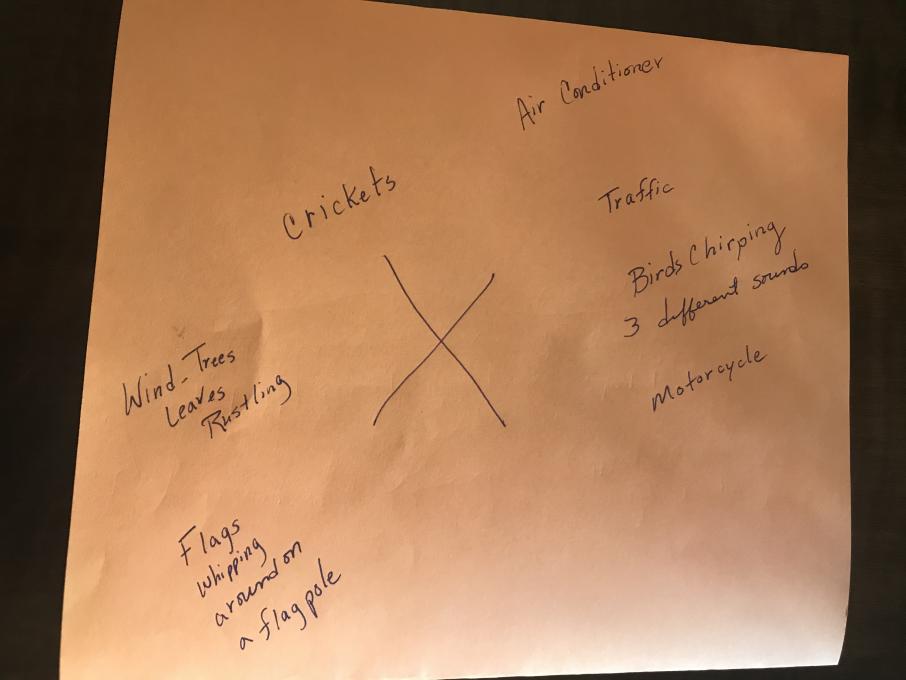
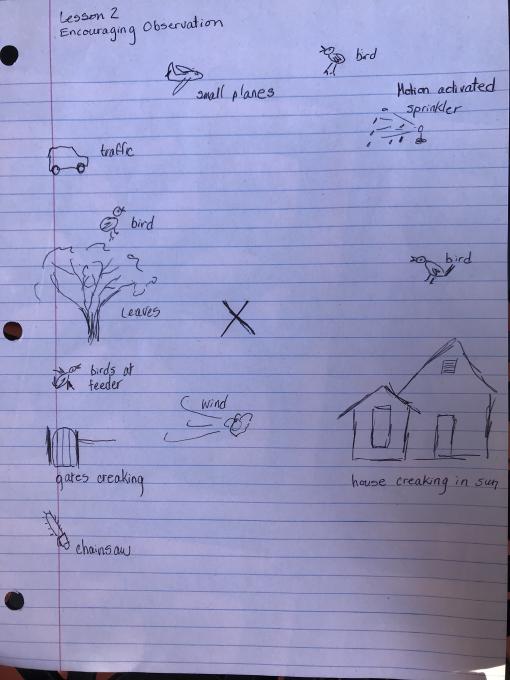

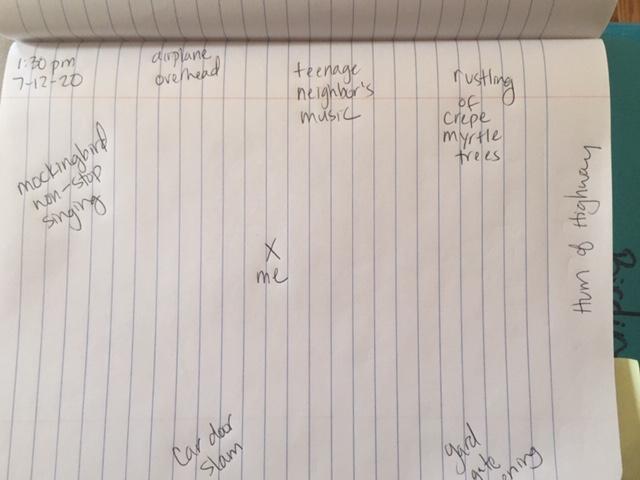
 I think for me it was a lot of heard was expected. For many of my student not having a "name" for the sound might be an issue and they may not write it down. I think we would need to talk about the fact that they may not have a name for the sound but it is still an observation and how important that is. I might be able to identify the bird call but a student might be able to tell that he bird sounds are different.
When it comes to doing the observations in general and using all their senses I think it will be important to note that taste will be the hardest to note.
I think having a conversation with kids about what it means to fully participate and observe will be one of the first things I have to start. Brainstorm ideas of what that looks like and maybe even feels like. Sometimes middle schoolers have a hard time just sitting and listening.
I think for me it was a lot of heard was expected. For many of my student not having a "name" for the sound might be an issue and they may not write it down. I think we would need to talk about the fact that they may not have a name for the sound but it is still an observation and how important that is. I might be able to identify the bird call but a student might be able to tell that he bird sounds are different.
When it comes to doing the observations in general and using all their senses I think it will be important to note that taste will be the hardest to note.
I think having a conversation with kids about what it means to fully participate and observe will be one of the first things I have to start. Brainstorm ideas of what that looks like and maybe even feels like. Sometimes middle schoolers have a hard time just sitting and listening.  Sound maps are a great tool to use with kids and adults alike. Not only does it help with observation skills but we all need to take a moment to take the time to focus on what we have and what is around us, instead on focusing on where we are going or what we need to do next. Emotional Health and mindfulness are an ever-growing topics. If we can get youth to slow down, gain a better sense of the world around them and pay attention to small details; and maybe ask them how they feel at that moment we will be teaching youth life skills they need to be successful. Does taking a break to be present help you feel calmer, relaxed? Sound maps are also a great way to get youth to observe and just be present in their surroundings. A jump for a more in-depth conversation later with youth making predictions, asking questions and following with open inquiry learning opportunities.
I also like the idea of “sit-spots.” A sit spot is an outdoor place that you spend at least 5 minutes while observing everything around you. When you choose a sit spot you want it to be easy to visit, free of distractions, comfortable and close to things that you want to observe.
Encourage youth to use their senses to observe and write in a journal about their observations to make inferences on changes they see overtime.
Look for movement. What animals do you see, what are they doing?
What did you hear in your sit spot? Do animals notice you? Do they get more comfortable with your presence?
What can you touch around you? Are certain plants softer when they are young? Do the mosses, rocks, trees and plants feel different when they are wet or dry? Does the sun feel good on your neck today?
Can you smell anything? If so, can you find it? Can you identify it?
Using a sit spot gently encourages us to be mindful of our surrounds and to appreciate ALL of the things that are happening around us. They help us to pause in our daily routine and to make sense of our natural surroundings while relying only on our own senses. Sit spots encourage critical thinking, independence and self-reliance while also getting us outside!
Week 2
Sound maps are a great tool to use with kids and adults alike. Not only does it help with observation skills but we all need to take a moment to take the time to focus on what we have and what is around us, instead on focusing on where we are going or what we need to do next. Emotional Health and mindfulness are an ever-growing topics. If we can get youth to slow down, gain a better sense of the world around them and pay attention to small details; and maybe ask them how they feel at that moment we will be teaching youth life skills they need to be successful. Does taking a break to be present help you feel calmer, relaxed? Sound maps are also a great way to get youth to observe and just be present in their surroundings. A jump for a more in-depth conversation later with youth making predictions, asking questions and following with open inquiry learning opportunities.
I also like the idea of “sit-spots.” A sit spot is an outdoor place that you spend at least 5 minutes while observing everything around you. When you choose a sit spot you want it to be easy to visit, free of distractions, comfortable and close to things that you want to observe.
Encourage youth to use their senses to observe and write in a journal about their observations to make inferences on changes they see overtime.
Look for movement. What animals do you see, what are they doing?
What did you hear in your sit spot? Do animals notice you? Do they get more comfortable with your presence?
What can you touch around you? Are certain plants softer when they are young? Do the mosses, rocks, trees and plants feel different when they are wet or dry? Does the sun feel good on your neck today?
Can you smell anything? If so, can you find it? Can you identify it?
Using a sit spot gently encourages us to be mindful of our surrounds and to appreciate ALL of the things that are happening around us. They help us to pause in our daily routine and to make sense of our natural surroundings while relying only on our own senses. Sit spots encourage critical thinking, independence and self-reliance while also getting us outside!
Sound maps are a great tool to use with kids and adults alike. Not only does it help with observation skills but we all need to take a moment to take the time to focus on what we have and what is around us, instead on focusing on where we are going or what we need to do next. Emotional Health and mindfulness are an ever-growing topics. If we can get youth to slow down, gain a better sense of the world around them and pay attention to small details; and maybe ask them how they feel at that moment we will be teaching youth life skills they need to be successful. Does taking a break to be present help you feel calmer, relaxed? Sound maps are also a great way to get youth to observe and just be present in their surroundings. A jump for a more in-depth conversation later with youth making predictions, asking questions and following with open inquiry learning opportunities.
I also like the idea of “sit-spots.” A sit spot is an outdoor place that you spend at least 5 minutes while observing everything around you. When you choose a sit spot you want it to be easy to visit, free of distractions, comfortable and close to things that you want to observe.
Encourage youth to use their senses to observe and write in a journal about their observations to make inferences on changes they see overtime.
Look for movement. What animals do you see, what are they doing?
What did you hear in your sit spot? Do animals notice you? Do they get more comfortable with your presence?
What can you touch around you? Are certain plants softer when they are young? Do the mosses, rocks, trees and plants feel different when they are wet or dry? Does the sun feel good on your neck today?
Can you smell anything? If so, can you find it? Can you identify it?
Using a sit spot gently encourages us to be mindful of our surrounds and to appreciate ALL of the things that are happening around us. They help us to pause in our daily routine and to make sense of our natural surroundings while relying only on our own senses. Sit spots encourage critical thinking, independence and self-reliance while also getting us outside!
Week 2
Sound maps are a great tool to use with kids and adults alike. Not only does it help with observation skills but we all need to take a moment to take the time to focus on what we have and what is around us, instead on focusing on where we are going or what we need to do next. Emotional Health and mindfulness are an ever-growing topics. If we can get youth to slow down, gain a better sense of the world around them and pay attention to small details; and maybe ask them how they feel at that moment we will be teaching youth life skills they need to be successful. Does taking a break to be present help you feel calmer, relaxed? Sound maps are also a great way to get youth to observe and just be present in their surroundings. A jump for a more in-depth conversation later with youth making predictions, asking questions and following with open inquiry learning opportunities.
I also like the idea of “sit-spots.” A sit spot is an outdoor place that you spend at least 5 minutes while observing everything around you. When you choose a sit spot you want it to be easy to visit, free of distractions, comfortable and close to things that you want to observe.
Encourage youth to use their senses to observe and write in a journal about their observations to make inferences on changes they see overtime.
Look for movement. What animals do you see, what are they doing?
What did you hear in your sit spot? Do animals notice you? Do they get more comfortable with your presence?
What can you touch around you? Are certain plants softer when they are young? Do the mosses, rocks, trees and plants feel different when they are wet or dry? Does the sun feel good on your neck today?
Can you smell anything? If so, can you find it? Can you identify it?
Using a sit spot gently encourages us to be mindful of our surrounds and to appreciate ALL of the things that are happening around us. They help us to pause in our daily routine and to make sense of our natural surroundings while relying only on our own senses. Sit spots encourage critical thinking, independence and self-reliance while also getting us outside! 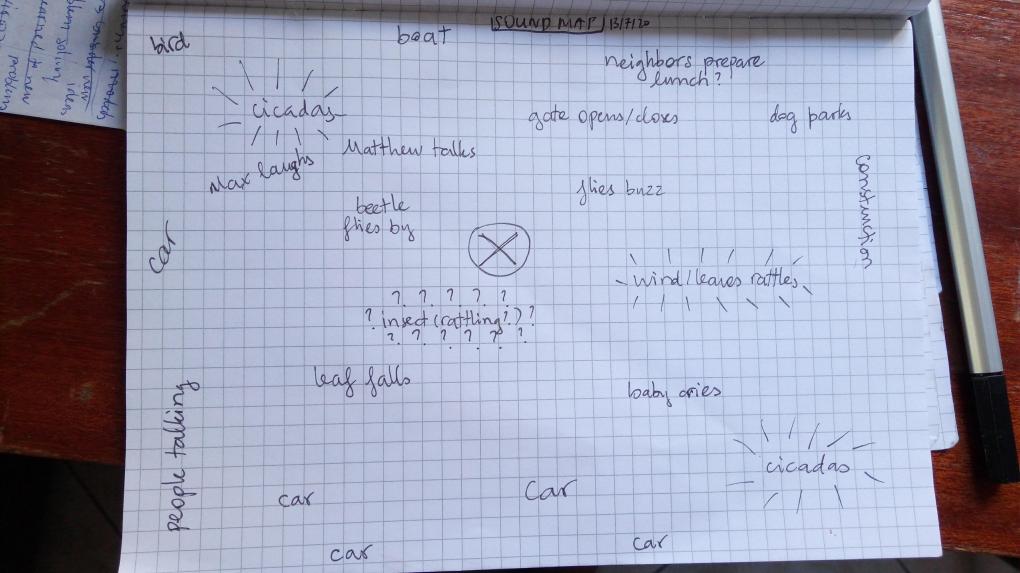
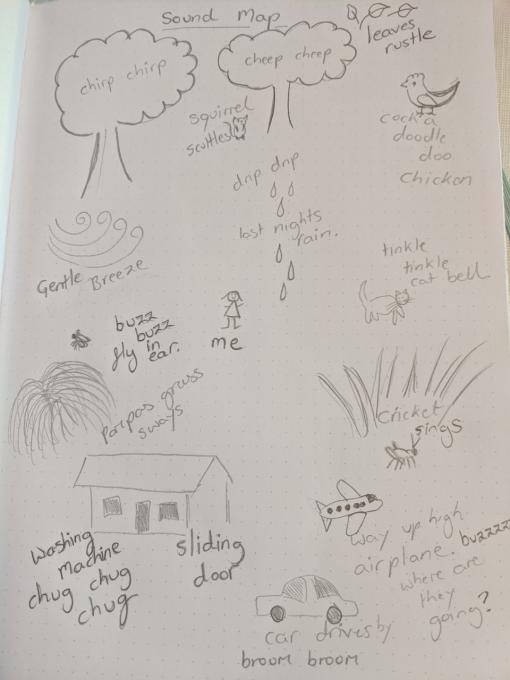 This activity forces you to stop, think and concentrate on what is already around you. Not on what you are cramming into your brain via smart phones etc. I think the time of ten minutes was needed because it took a while to settle down and really focus on everything. I sat for a while with my eyes closed and that helped me focus even more. I think having students complete this activity is a good way to introduce them to the world around them and make then start to see / hear. it would be interesting to complete the map only focussing on other senses such as touch and smell. I can see a lot of extension activities for this concept.
This activity forces you to stop, think and concentrate on what is already around you. Not on what you are cramming into your brain via smart phones etc. I think the time of ten minutes was needed because it took a while to settle down and really focus on everything. I sat for a while with my eyes closed and that helped me focus even more. I think having students complete this activity is a good way to introduce them to the world around them and make then start to see / hear. it would be interesting to complete the map only focussing on other senses such as touch and smell. I can see a lot of extension activities for this concept. 



 A favorite read aloud for this lesson is the Listening Walk by Paul Showers, illustrated by Aliki. The students quickly learn to observe and listen to the sounds around them once they are introduced to this lesson. Every time they are outside, they are more in tune to the sounds of nature and are excited to share.
A favorite read aloud for this lesson is the Listening Walk by Paul Showers, illustrated by Aliki. The students quickly learn to observe and listen to the sounds around them once they are introduced to this lesson. Every time they are outside, they are more in tune to the sounds of nature and are excited to share. 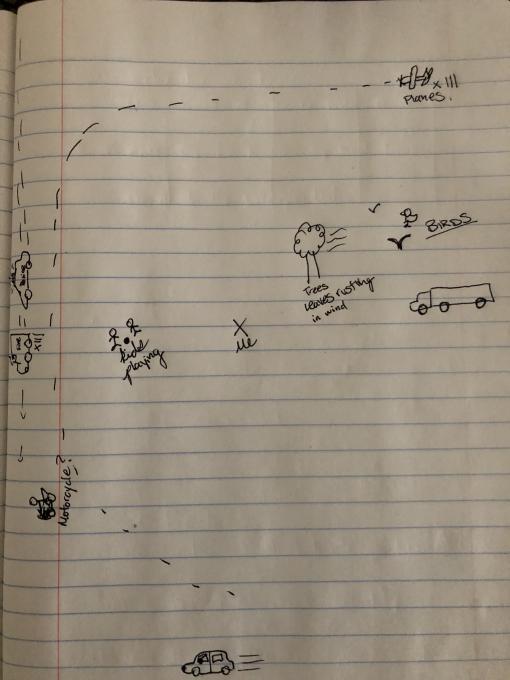

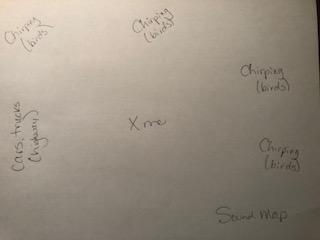 I
I usually listen to the sounds outside because I am always trying to identify the birds that are near by me. I have not made a Sound Map before today. I think this is a great idea to share with students. It is an easy way to engage students with their natural surroundings. For students who enjoy drawing and sketching, the Sound Map could lead to activities in art for them. Even if students don't know the name of the bird that is making the sound, the student will be able to use their imagination to draw what the bird might look like as it is singing.
I
I usually listen to the sounds outside because I am always trying to identify the birds that are near by me. I have not made a Sound Map before today. I think this is a great idea to share with students. It is an easy way to engage students with their natural surroundings. For students who enjoy drawing and sketching, the Sound Map could lead to activities in art for them. Even if students don't know the name of the bird that is making the sound, the student will be able to use their imagination to draw what the bird might look like as it is singing. 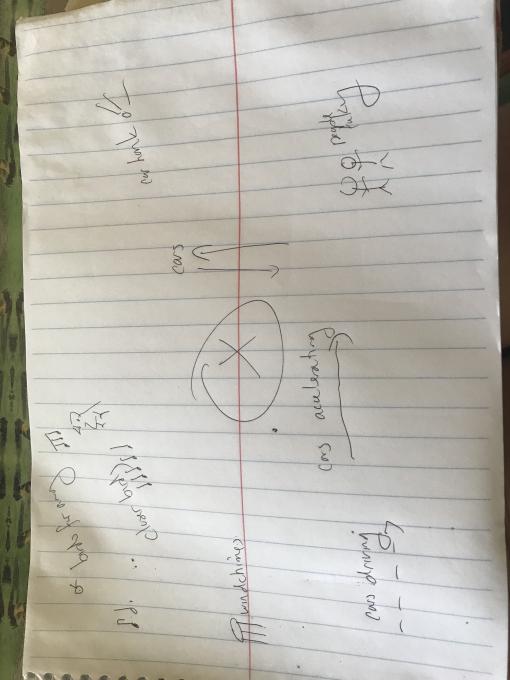
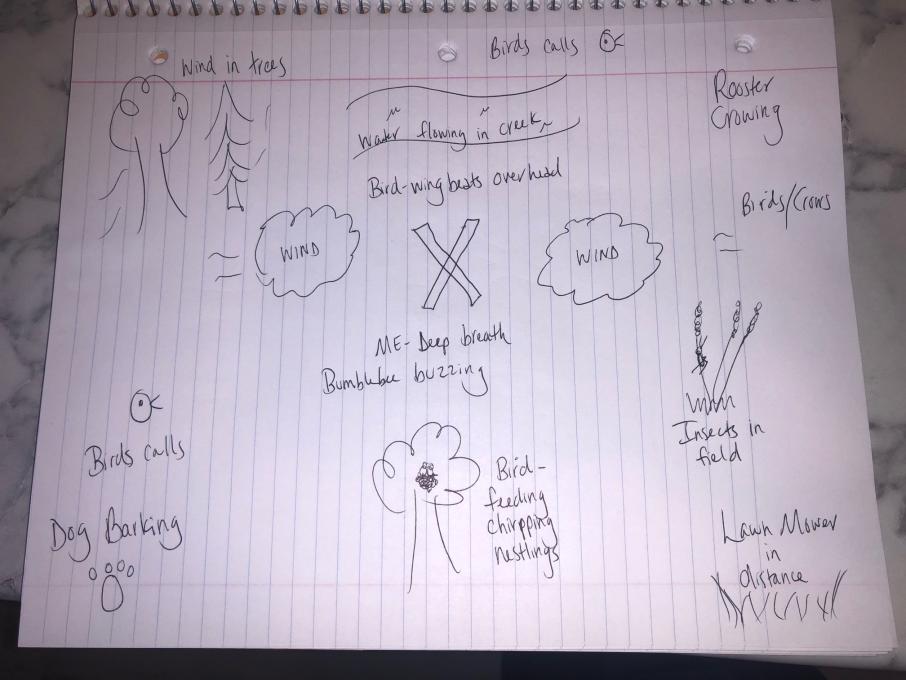 use their senses to locate food.
use their senses to locate food. 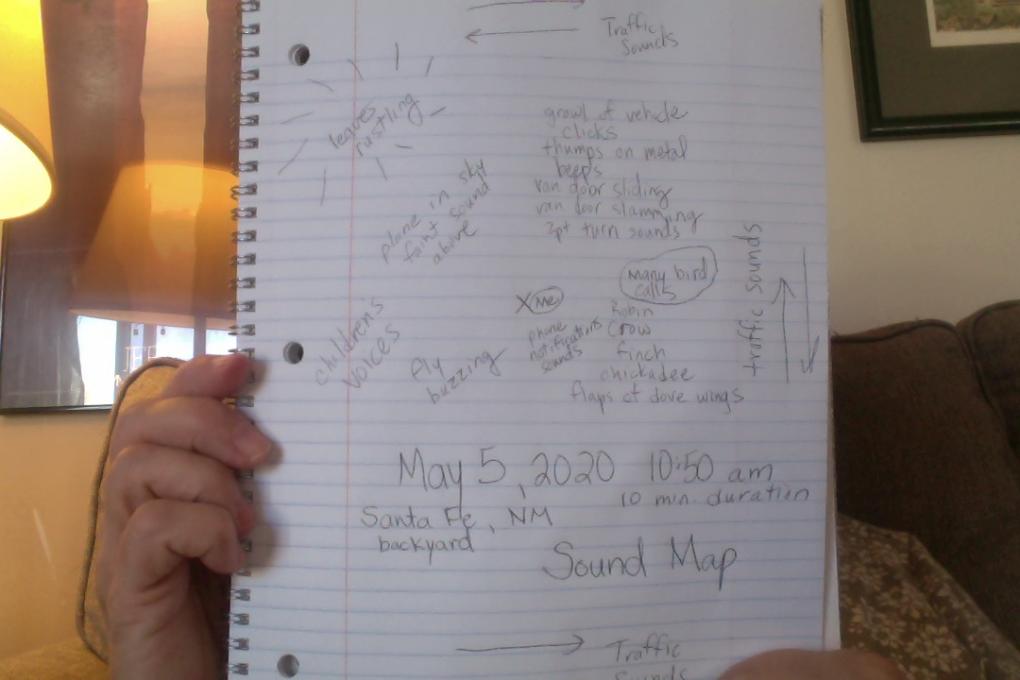 My realization of how I became more and more able to be specific the longer I listened.
Practicing and then reflecting bring the concept home in the mind.
My realization of how I became more and more able to be specific the longer I listened.
Practicing and then reflecting bring the concept home in the mind.
